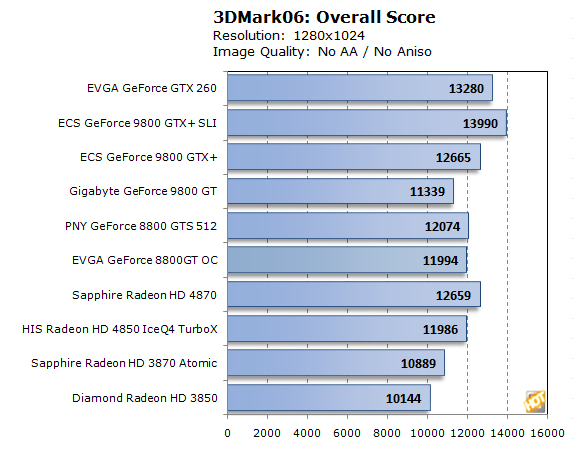ECS GeForce 9800 GTX+ Hydra, Liquid Cooled SLI
HOW WE CONFIGURED THE TEST SYSTEM:
We tested all of the graphics cards used in this article on either an ASUS Striker II Formula nForce 780i SLI motherboard powered by a Core 2 Duo E6800 dual-core processor and 2GB of low-latency Corsair RAM. The first thing we did when configuring the test system was to enter their BIOS and set all values to their "optimized" default settings. Then we manually configured the memory timings and disabled any integrated peripherals that wouldn't be put to use. The hard drive was then formatted, and Windows Vista Ultimate and the latest DX10 update was installed. When the installation was complete, we then installed the latest chipset drivers available, and installed all of the other drivers necessary for the rest of our components. Auto-Updating and System Restore were also disabled and the hard drive was defragmented.
 |
|
|
Video Cards - Memory - Audio - Hard Drive -
|
Hardware Used: |
OS - DirectX - Video Drivers - Synthetic (DX) - Synthetic (DX) - DirectX9 - DirectX10 - DirectX10 - OpenGL - |
Relevant Software: Windows Vista Ultimate DirectX 10 NVIDIA Forceware v177.41 (GTX 260) NVIDIA Forceware v177.19 (98xx) NVIDIA Forecware v175.19 (88xx) ATI Catalyst v8.8 Benchmarks Used: 3DMark06 v1.0.2 3DMark Vantage Half-Life 2: Episode 2 Company of Heroes Crysis Enemy Territory: Quake Wars* * - Custom Test (HH Exclusive demo) |
 |
|
| 3DMark06 is a synthetic benchmark, designed to simulate DX9-class game titles. This version differs from the earlier 3Dmark05 in a number of ways, and includes not only Shader Model 2.0 tests, but Shader Model 3.0 and HDR tests as well. Some of the assets from 3DMark05 have been re-used, but the scenes are now rendered with much more geometric detail and the shader complexity is vastly increased as well. Max shader length in 3DMark05 was 96 instructions, while 3DMark06 ups that number to 512. 3DMark06 also employs much more lighting and there is extensive use of soft shadows. With 3DMark06, Futuremark has also updated how the final score is tabulated. In this latest version of the benchmark, SM 2.0 and HDR / SM3.0 tests are weighted and the CPU score is factored into the final tally as well. |

A single ECS GeForce 9800 GTX+ card seems to be running along well enough on its own as it meets the performance of Sapphire's Radeon HD 4870 head-on, and only behind the lead GeForce GTX 260 by 600 Marks. Throw in that second card in SLI, and ECS grabs the top spot all for itself. The SLI numbers are ~1300 Marks higher than a single card mustered - roughly a 10% increase in overall performance.

In the individual shader models scoring, we see that the 9800 GTX+ is still sitting pretty with the second highest numbers in Shader Model 2.0 testing, yet only fourth best with the Shader Model 3.0 benchmarks. It was quickly surpassed by the two latest higher-end releases from ATI - the Radeon HD 4870 and the more similarly priced HD 4850. Back to SLI testing, we saw little if any improvement in the SM2.0 results, but SM3.0 really took off blowing well past the HD 4870 and GeForce GTX 260 numbers, and topping out just shy of 8000 Marks.







